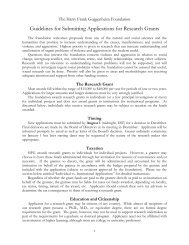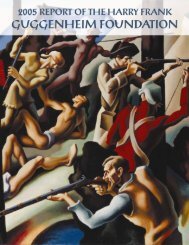Small Arms and Light Weapons - Harry Frank Guggenheim ...
Small Arms and Light Weapons - Harry Frank Guggenheim ...
Small Arms and Light Weapons - Harry Frank Guggenheim ...
- No tags were found...
Create successful ePaper yourself
Turn your PDF publications into a flip-book with our unique Google optimized e-Paper software.
ing instability <strong>and</strong> violence brought all developmentprojects to a halt.• In El Salvador, a UN-brokered peace hadbrought a vicious civil war to a close in 1992. Butby 1995 the country was ablaze with armed violence,this time by criminals armed with morethan 200,000 military weapons left over from thecivil war.• In Rw<strong>and</strong>a, more than 800,000 Tutsis <strong>and</strong> manyHutus were massacred at the direction of theHutu government, made possible by the distributionof weapons brought into the country forthis purpose.• In Sri Lanka, an intractable civil war raged, withthe government facing a Tamil insurgency thathad established a global network of illicit armssupplies.• In the former Soviet Union, states with only armsindustries left as viable commercial enterpriseslegally sold hundreds of thous<strong>and</strong>s of small arms<strong>and</strong> light weapons to governments involved inconflicts, many of which were illegally diverted toarmed groups bent on perpetuating conflicts.Ten years after the small arms problem burstonto the world stage, there is a clear consensus thatit is key to the underst<strong>and</strong>ing <strong>and</strong> control of contemporaryviolence. The proliferation <strong>and</strong> misuseof small arms <strong>and</strong> light weapons (SALW) occurs ina variety of contexts: receding conflict, post-conflict,<strong>and</strong> high-crime areas. Today there are over600 million SALW in circulation worldwide. Of49 major conflicts in the 1990s, 47 were wagedalmost exclusively with small arms. <strong>Small</strong> arms areresponsible for hundreds of thous<strong>and</strong>s of deathsper year, including 200,000 from homicides <strong>and</strong>suicides <strong>and</strong> perhaps 300,000 from political violence.A wide range of negative consequences fromtheir use has been revealed: deaths <strong>and</strong> injuries toinnocent civilians, human rights violations, denialof socio-economic development; sparking, fueling,<strong>and</strong> prolonging conflicts; obstruction of humanitarianrelief programs; undermining of peace initiatives;diminishing the security of vulnerablegroups such as women, children, refugees, <strong>and</strong>internally displaced persons; <strong>and</strong> increasing thepublic health burden from violence.A Research Field EmergesAs this reality emerged in the mid-1990s, so didthe need for information <strong>and</strong> knowledge aboutthese weapons. Why? As a class these weapons <strong>and</strong>their effects are very different from larger conventionalweapons. They are smaller, more portable,cheaper, simpler to use, <strong>and</strong> easily available to nonstateactors. What we knew about the trade <strong>and</strong>production of larger weapons such as tanks <strong>and</strong>fighter aircraft was hardly enough to provide guidanceto policymakers. The research questionsregarding small arms went far beyond traditionalnational <strong>and</strong> international security, which concernedonly the state.The goal of this publication is to provide anintroduction to the research field of small armsthat emerged as a result of this new reality. To date,this work has been primarily policy research,designed for <strong>and</strong> produced by nongovernmentalorganizations (NGOs), international governmentalorganizations (IGOs), <strong>and</strong> national governmentsinvolved in addressing this problem. This researchhas focused on practical policy variables <strong>and</strong> developing<strong>and</strong> testing programs, interventions, <strong>and</strong>services. As a result, program-evaluation methodologiestend to have an important place in thefield. This policy research has also been characterizedby strict time constraints, placed on researchersby donor governments <strong>and</strong> international organizationsactive in seeking policy solutions. 2The academic community was rarely engaged indebate about these policies or in systematic testingof practices enacted to stem the flow of small arms.The time has come to enlist the full range of academicdisciplines to exp<strong>and</strong> the knowledge baseneeded to reduce the damage wrought by small4




